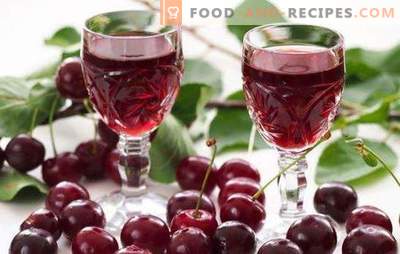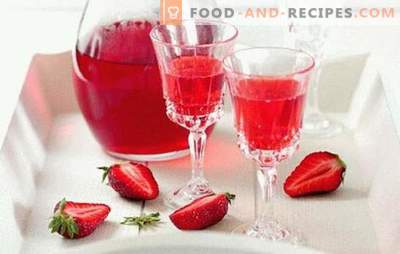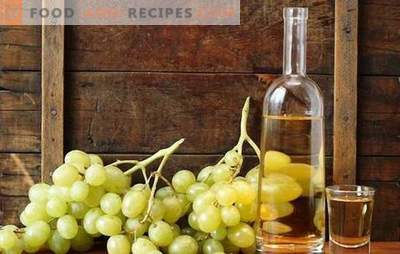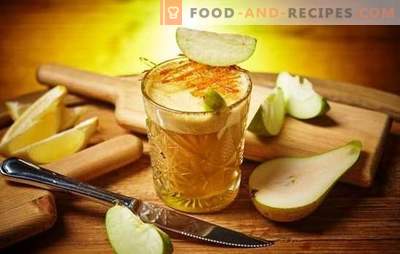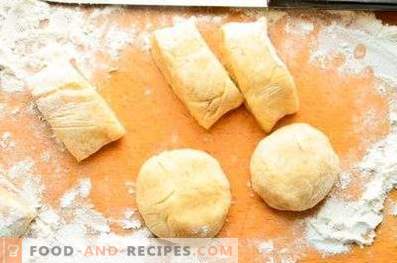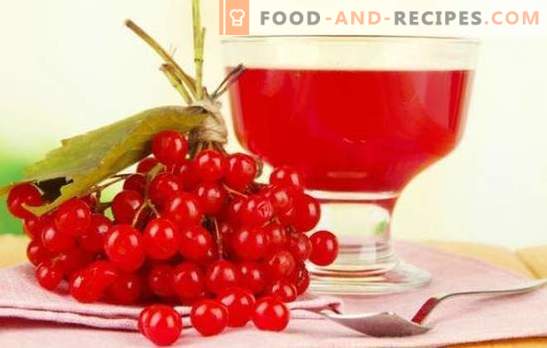
Recipes of dishes, desserts and drinks from viburnum berries, perhaps, are known only in temperate latitudes.
The scarlet clusters have long and firmly connected not only with the Slavic culture, traditions and rituals, but also with delicious cakes, kissels and brooks.
Recipes made from viburnum at home can be considered with certainty the national peculiarity of the Russian people, which came from time immemorial, from our ancestors.
Pouring viburnum at home - the basic principles of cooking
Among the fruit and berry abundance that has become available due to the benefits of civilization, the modern consumer viburnum is increasingly remembered only as a medicinal raw material, recognized by official pharmacology, or a means often used in traditional medicine.
It is in vain! The winter berry has an invaluable set of useful vitamins, micro and macro elements, is a source of essential amino acids and minerals. Viburnum berries can not be found on the shelves of supermarkets, but, nevertheless, if you wish, you can collect them on the backyard or in the forest, in the park, wherever there is moist soil.
It does not need to say that the cost of the source of health and beauty will consist only in the time spent on a useful walk in the fresh air, which is a great advantage over going to the supermarket, associated with considerable costs for the purchase of exotic fruits processed before transporting special and not very useful chemicals.
Viburnum berries have a light bitterness and astringency of taste due to their glycoside content of viburnin. Perhaps the presence of this bitterness is not to the liking of many, but the taste in the frozen berries disappears, while retaining all the valuable properties of viburnum.
The specific, bitter taste of the berries can be a “highlight” for homemade viburnum liqueur. After all, the same glycosides are added artificially to vermouths and sherries, precisely to give the drink a slight bitterness, which makes the taste of these wines special. We take into account this nuance. Pouring - liqueur in the Russian version, but with a lower strength and high sugar content. The basis of the liqueurs are fruit and berry juices extracted from vegetable raw materials by extraction.
The main method of cooking liqueur.
In the industrial production of low alcohol beverages occurs in five stages:
• Preparation of vegetable raw materials: sorting, grinding;
• Blending: mixing ingredients;
• Filtration: the infused material is cleaned from plant elements and sediment;
• Extract: a stage necessary for obtaining the corresponding taste and aroma;
• Filling.
Sorted fruit material is crushed and placed in containers, where it is infused for 10-12 days. For extracting (extracting) juice, flavored or simply purified ethyl alcohol diluted with water up to 40-50% is used. After the plant fiber is destroyed by alcohol, the resulting alcoholized juice is separated from the sediment. The remains of plant materials are compressed, then filtered and combined first with the alcoholized juice of the first drain, and then with the sugar syrup and other components provided by the recipe. The next stage - blending (mixed) raw materials are kept for up to 72 hours or more, to obtain the necessary flavor and taste. After aging, the brandy is again filtered and sent to the bottling plant. After the bottling plant, the corked bottles are kept at a temperature of 8 ° -20 ° C for one to six months. The duration of exposure of special liqueurs reaches two years or more.
The preparation of homemade liqueur according to the production technology is not fundamentally different, but it does allow for some changes.
If there is no alcohol, which is used in the industrial production of liquor, it can be replaced with vodka, brandy, brandy, rum. You can use moonshine, if you are confident in the quality of its cleaning. Another important condition: the presence of unpleasant smells of fusel oils is unacceptable, as they will spoil the flavor of the liqueur. Other ways to create a homemade liqueur. Non-alcoholic
In the recipes that occur every now and then in various resources, you can find such a phrase as "non-alcoholic liqueur." A careful reading of such a recipe makes it clear that this is not about pouring, but about the long-term pasteurization of fruit in its own juice. Then this natural compote is diluted with water, calling this liquid liqueur. Even if alcohol and syrup are added to such a juice preparation, you will still get, at best, a cocktail, but not liqueur.
Among the technologies used in the domestic kitchen can be reproduced two more ways:
• Fermentation of juice or pulp, with further blending. The main stages of this method of making liqueurs are the preparation of wine and blending it with juice, water, flavored liqueurs, adding syrup or sugar
• Partial digestion, with fermentation stopped. By the same principle kvass, lemonade, cider is prepared.
In the process of fermentation, it is quite easy to separate the juice from the plant fiber. After pressing and filtering the wort, a low-alcohol, carbonated drink is obtained. Its further processing consists in blending and bottling. Such drinks are stored briefly, at low temperatures.
Cider, kvass, spiking, lemonade also belong to the subspecies of sweet, low-alcohol liqueurs, containing up to 7-8% alcohol.
Other criteria
The strength of liqueurs made in the home can vary from 12 to 45%, if desired. It should be borne in mind that liqueurs with a fortress over 15% can be stored for up to two years or more, at room temperature. With such an alcohol content in the pouring stops the vital activity of wild yeast, which are present in the fruit components.
The content of sugar or other sweeteners can also be varied based on personal preference. In the domestic production of liqueurs, the requirements of GOST can be disregarded, if it does not harm health. For ladies' liqueurs, the sugar content can be increased up to 40%. If the drink is prepared for hussars, then you can increase its strength, and reduce the sugar content and add viburnum for light bitterness, which the frost has not “kissed” yet. A high percentage of sugar in the liquor forms a stretching and thick consistency of the drink, giving the liquor a special look and taste.
To more accurately determine the alcohol content in homemade liqueurs, it is more convenient to use an alcohol meter.
Depending on the raw materials used and the method of production, the liqueurs are divided by production time:
Early ripening: the preparation time of such liqueurs can vary from several days to one month. Fast ripening is made from berries that have a shelf life of not more than 2-5 days at a temperature of 0 ° C. This, for example - strawberries, raspberries, currants, gooseberries.
Mid-season: liqueurs with a ripening period of 1.5-3 months. The raw materials for the preparation of mid-ripening liqueurs are usually stone fruit: plum, cherry, apricot, cherry plum, viburnum, peach.
The process of making late ripening takes from 3 to 6 months. Fruits for late ripening have a long shelf life: pears, apples, quince and other pome fruits.
The basic recipe for homemade viburnum liqueur
The use of viburnum berries in the production of alcoholic beverages is a rarity. This raw material on an industrial scale is used only for the production of medicinal tinctures.
Viburnum berries contain more than 30% invert sugar. But the content of vitamin C is large enough - more than lemons.
Therefore, for the preparation of the classic Kalinova liqueur use the ratio of: berries - 1 part, sugar - 2 parts.
First method:
For the main recipe, fresh berries are sorted and slightly dried. Frozen berries are allowed to thaw and drain. Berries knead before extracting juice. Prepared viburnum is placed in a glass, enameled or ceramic container, filling it with 2/3 volume of berries. Then the berries poured vodka or alcohol, diluted with water to 50%. After about two weeks, the resulting alcoholized juice is drained and filtered. Sugar and purified water are added to the remaining berries to cover the berries. After another two weeks, the resulting syrup is drained, filtered and combined with Kalin's tincture. The combined extracts can withstand up to 72 hours, repeatedly and intensively kneading, re-clean and send for an exposure of up to three months. The finished bottling is bottled and sealed. Second Method:
Berry knead, falling asleep their sugar and at the same time adding vodka. The finished liqueur is poured after a month and a half, then passed through a multilayer filter and bottled.
Procurement of ingredients for pouring viburnum
Viburnum pouring, using various ingredients for blending:
• Spicy and medicinal plants;
• Spices;
• Any fruits or berries, and also preparations from them;
• From alcoholic ingredients it is possible to diversify the assortment of liqueurs using cognac, rum and alcohol extracts with various flavors;
• As a sweetener, you can use not only sugar, but also fructose, honey, invert syrup.
Actually, you can do and vice versa: stock up with viburnum tincture, frozen berries or viburnum berries ground with sugar, and then prepare a blending liqueur in the season of raspberries, peaches, melons or other gifts of nature.
Recipe 1. Pouring from viburnum at home, with raspberry tincture
Raw materials:
• Viburnum berries, frozen 2 kg
• Crimson tincture (on vodka) 2 l
• Sugar, refined 4.5 kg
• Purified water 1 l
Preparation:
For pouring need raspberry tincture, cooked in the season of collecting raspberries. Raspberry berries, stretch 2 liter jars and cover them with two liters of vodka for 15 days. Capacity to tightly cover. After pouring the tincture through the filter. Keep the tincture away from sunlight.
Prepared berries of Viburnum slightly stretch and pour a raspberry tincture. Stir the contents every day for a month. The container must be carefully closed so that the alcohol does not evaporate. Drain the alcoholized juice and strain. Dissolve the sugar in warm water and pour the sweet water into a container of viburnum berries. To sustain 10 days, also constantly mixing. After filtering and combine with the alcoholized juice of the first drain. To sustain 8 weeks. Once again, clear the sediment and pour the finished liqueur into the prepared container. If you use frozen berries for making liqueurs, then after thawing, you can not squeeze them, but then water should be added less than the specified volume (0.7 l).
Recipe 2. Pouring from viburnum at home, with pine cones jam
Raw materials:
• Kalina 1.2 kg
• Pine cones jam - 2 liter jars
• Vanilla - 1 bag
• Water 700ml-1l
• Wine alcohol (50%) - 1.5 l
Preparation:
Mash viburnum berries and mix with pine cones jam and pour alcohol for 15-20 days. At the beginning of the bookmark add and vanilla. The resulting alcohol juice after the expiration date is poured through a filter into a clean glass jar. Pour the rest of the thick water, bring to a boil, but do not boil. Cool and filter. Connect the first and second drain. Soak for about a month, stirring the brandy daily.
Recipe 3. Infusion of viburnum at home “Heather honey”
Raw materials:
For tincture:
• 1 liter of purified alcohol;
• Heather, dried - 200 g
• Kalgan (Lapchatka) root - 50 - 60 g
For pouring:
• 2 kg of flower honey
• 1.5 liters of filtered water
• 1.0 kg of viburnum berries
Cooking technology:
Prepare tincture: chopped vegetable raw materials to withstand about a month in alcohol. Filter.
For making liqueur, use the basic cooking method No. 2.
Recipe 4. Pouring from viburnum at home, with honey and mint
Raw materials:
Mint tincture (50%) - 2 l
Kalina (thawed berries) 2.5 kg
Honey (herbs) 2 kg
Filtered water 1.5-2 l
Cooking:
For mint tincture, fresh peppermint leaves are used (200 - 250 g). Finished mint tincture is used to create the liqueur in the first main method.
Recipe 5. Pouring from viburnum at home, low alcohol
Raw materials:
• Kalina 0.5 kg
• Juice, apple (not clarified) 3 l
• Sugar 1.6 kg
• Cinnamon 1 stick
• Raisin 150g
• Vodka 0.5 L Cooking:
Freshly squeezed apple juice combined with 0.6 kg of refined sugar. To start the fermentation add raisins. Place the dish with juice in a warm place, wearing a rubber glove on the neck. When apple foam rises to the surface, remove it.
At the same time set to insist on vodka berries Viburnum. To do this, they need to be ground, put in a jar with a cinnamon stick and pour with vodka for as long as the apple wine is lightened.
When the raisins sit on the bottom of the jar and fermentation stops, put the wine in a cool place to settle. Remove from sediment. A small amount of wine is poured from the bottle and heated, dissolving one kilogram of sugar in it. Pour it back into the wine bottle and set it again, for a day, in a warm room, waiting for the wine to warm up, and bubbles will start to appear. Filter the snowball tincture. Pour the tincture into the wine, mix and pour the pouring into bottles for champagne, without pouring it up to the beginning of the neck. Store in the basement or refrigerator for no more than six months.
Recipe 6. Pouring from viburnum at home “Lime blossom”
Raw materials:
• Water - 100 - 200 ml
• Sugar 1.0 kg
• Linden flowers
• Vodka 1 cup (200 ml)
• Viburnum berries, thawed 500 g
Cooking technology:
Wash the collected lime color, shake off the water and tamp tightly into the jar. It is better to flower the flowers so that the fragrance opens. Pour lime vodka and tightly screw the cap on the bank. We remove from the sun for a month, and then squeeze the flowers and filter the tincture. With the prepared tincture we prepare the liqueur from viburnum berries according to the second method.
Recipe 7. Pouring from viburnum at home, honey, with thyme aroma
Raw materials:
• Alcohol, purified 500 ml
• Thyme, dried 100 g
• Honey (forbs), liquid 1 liter can
• Kalina, berries 400 g
• Spring water 1 l
Cooking:
Viburnum berries pound in a mortar or other suitable utensils with thyme and pour undiluted alcohol for 20 days. After the prepared tincture pass through a multi-layer filter. Dissolve honey in warm water and combine this water with tincture of thyme and viburnum. Capacity to remove for aging for two months. If necessary, after aging, remove from the sediment again and pour into the prepared container.
Recipe 8. Pouring from viburnum at home, precocious
Raw materials:
• Sugar 3.5 kg
• Young grape wine (nutmeg) 5 l
• Viburnum berries, thawed 1.5 kg
• Water 1 liter
• Alcohol, purified 0.5 l
Cooking:
Combine crushed berries of Viburnum with sugar and alcohol. Add water to the berries covered with liquid, and the sugar is completely dissolved. Approximately, after three weeks, through the filter, pour the finished liqueur, and add it to the young, just removed from the sediment, grape wine. To withstand a drink for three days at a temperature of 18 to 24 degrees, then pour into bottles for champagne and bring to the cold. Store at a temperature of 5-14 ° C in a horizontal position.
Recipe 9. Pouring from viburnum at home “Holiday”
Raw materials:
Fresh, orange - 2 l
Orange peel
Sugar 2.5 kg
Rum - 700 ml
Kalina, bitter 0.5 kg
Cooking technology:
After removing the zest from the oranges, pound it with viburnum berries and pour a bottle of your favorite rum. Combine fresh orange juice with sugar and heat until completely dissolved. Do not boil. Warm syrup clean in cold. Rum tincture, combined with viburnum juice and lemon peel after a day, drain and combine with orange syrup. Pouring ready. It can be served to dessert.
Pouring viburnum at home - tricks and tips
• If you get a stronger liqueur than was intended, you can remove excess alcohol using pasteurization. Drink tank immersed in hot water. The lid of the utensil in which the liquor is located must be opened so that the alcohol can evaporate during heating. But do not overdo it so that you do not have to add alcohol again.
• Pouring can be successfully used for confectionery production. This is the best impregnation for biscuit, an excellent flavor for creams, souffles, jellies and mousses.
• Viburnum liqueur can be prepared at any time of the year if you stock up with alcoholized juice during the season of ripe berries. This method will save space in the freezer and at the same time save the desired flavor in the alcohol extract. Use this technique for any fruits and plants, if you prefer alcoholic beverages of own production.


